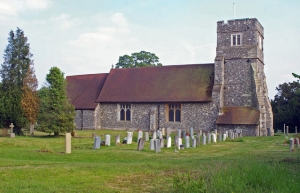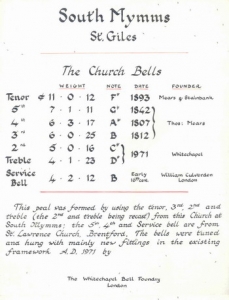St Margarets Church Guide
Walk around guide to St Margaret’s Church
The Parish
Ridge Parish was formed in the late 13th century of lands belonging mainly to St. Albans Abbey. Until 1870, the parish remained in the Liberty of St Albans. From 1870 it has formed part of Hertfordshire. Up to 1956, the parish included a detached area between Borehamwood and Shenley; this may be what the Doomsday Book of 1086 refers to as ‘the Abbotts land at Shenlai’.
The parish consists of approximately 3000 acres of Green Belt land; in 1981 the population was still only 300. The parish is over six miles long, running from Galley Lane, Arkley, to Colney Heath.
The Church
[two_third last=”no” class=”” id=””]
The chancel dates from the 14th century, and probably formed a tiny church on its own. The Roman road from London to St Albans passed nearby, and the church may have been intended as a landmark for those entering the domain of the Abbot. The nave and tower were added in the 15th century. The church was extensively decorated with wall paintings, of which one complete example survives.
In 1740-46 major repairs were carried out and the church furnished with box pews and a three-decker pulpit. In 1810, a gallery was placed at the west end and dormer windows inserted into the roof.
The church was again restored in 1881, when ceilings, gallery and dormer windows were removed, the porch rebuilt, and a new arch cut between nave and chancel, destroying most of a medieval doom- painting which survived under the whitewash.
Since 1945, further repairs have been carried out, including the re-flooring and re- furnishing of the chancel. The roof was renewed in 1976, and the stonework of the tower repointed and partially replaced in the 1980s. Before applying new limewash in 1989, examination of the remaining fragments of medieval wall-painting was carried out, but nothing was found extensive enough to warrant restoration.
[/two_third]
[one_third last=”yes” class=”” id=””]
[/one_third]
Tour of the church
The Nave
The wall painting of St. Christopher carrying our Lord across a river dates from the 15th century, probably by the same hand as the wall paintings of this date in St Albans Abbey. It was restored by Professor Tristram in 1937, and has since received further treatment. A detailed description can be seen on the adjacent window cill.
The Royal Arms on the north wall are those of George III, done in tapestry work. The painted board hanging below, dated 1814, was found on the back of the frame.
At the west end are a tablet recording a ‘Compleat Peal of 120 changes’ rung in 1777, and another recording a similar peal rung in 1977, the Queen’s Jubilee Year.
The glass in the south-west window, designed by Alfred Fisher of Chapel Studio, was given by Julian Watson in memory of his family in 1991.
On the south wall are memorials to the Jennings family: William and Jane, both d.1809, Sophie d.1814, Louisa d.1826, Richard d.1848, Agnes d.1874, Edward d.1875, Richard d.1891, and Margaret d.1903. There is also a memorial to Joseph Bushnan, Comptroller of the City of London, d.1791 and his wife Agnes d.1828.
The oak lectern was given in memory of Hilda Jessie Cunnington d.1949. The oak pulpit was made by Robert Thompson of Kilburn, Yorkshire, (the ‘Mouseman’) in 1957; it replaces a large stone pulpit said to have been rejected by Christ Church, Barnet, in the 19th Century.
The only medieval glass to survive can be seen in the upper lights of the window by the pulpit; the fragments date from c.1390.
In the floor by the pulpit is a black polished slab to Thomas Baker d.1729, Consul in Tripoli 1677-86. Other slabs in the nave floor include those to Mary Lloyd d.1741, Mary Hills d.1744, Joseph Bushnan d.1797, William Bayles d.1805, and Sarah Jefferson d.1813. Although her husband Jacob Jefferson, Vicar of Ridge from 1801-32, is named on the stone, he was buried elsewhere.
The Chancel
The east window, by Ward & Hughes, commemorates Jane, Countess of Caledon d.1893. The central figure is St Margaret of Antioch, to whom the church is dedicated. In the 1980s, new glass by Chapel Studio was inserted in the south windows in memory of Bessie Fortnam, Richard Hatt Auty, and the Copps family. On the south wall of the sanctuary are an alabaster cartouche and panel to ‘Ye Lady Busby’ d.1661. Beneath is a 14th century piscina. The credence shelf in the window and an oak table are memorials to Benjamin Price, Vicar from 1964-71. Between the south windows is a brass plate to William Clarke, Vicar from 1893-1933.
On the north wall are tablets to James Yorke d.1816, and John Willis, Vicar, d.1799. The window cill is inscribed to Edith Mary Behrend d.1954. There is also a brass plate to Catherine, Countess of Caledon d.1863, and oak roundels to Maude Chennells d.1958, organist for 64 years, and Ettie Auty d.1990, who gave the present organ, by Cousans of Lincoln, 1936. This organ once stood in St Modwen’s Church, Sutton-in-Ashfield, and came to Ridge in 1989.
In the floor is a large Bethersden marble slab with indents for brasses (now lost) believed to commemorate Sir Thomas Pope Blount d 1652. Eastwards is a black polished slab to John Major, Vicar, d.1708 and his wife Elizabeth d.1718.
The oak furniture in the chancel was all made by Thompson of Kilburn in 1965, and given by Major Behrend in memory of his wife Edith.
The Hatchments
In the chancel hangs the hatchment of the 3rd Earl of Hardwicke d.1834 (buried at Wimpole, Cambs.). The hatchments in the nave are of the Bushnan, Hearne, and Jennings families. The charges for these hatchments are noted in one of the church registers.
The Tower
[two_third last=”no” class=”” id=””]
In the vestry at the base of the tower are memorials to Elizabeth Hearne d.1825, Thomas Hearne d.1846, his sister Elizabeth d.1837, and Elizabeth Crawford Taylor d.1854.
The tower originally contained three bells hung in a timber frame made by Thomas Sermon in 1740, and repaired in 1890. They were:
Tenor – G – 11 cwt ; Second – A – 8 cwt and a Treble – B – 6½ cwt
However, in 1994, bell ringing stopped due to the fact that the bell ringing floor and bell frame were found to be unsafe. With the help of Lottery Funding, a grant from Hertsmere Borough Council and money raised by the congregation, they were subsequently replaced; the work being completed in July 1998, the bells being re-hung. At the same time two new bells and a redundant bell (1889) were added, making six in all.
[/two_third]
[one_third last=”yes” class=”” id=””]
[/one_third]
Church Plate, Ornaments and Registers
There is a silver chalice and paten (paten said to date from 1686) inscribed ‘Ridge Church 1740 the gift of Katherine the Lady Blount’. A silver plated flagon inscribed ‘Ridge Church’ was said to be 18th century, but is certainly early 20th century. A smaller chalice and paten commemorate W. Martin Hume d.1964. The silver plated processional cross, made by Leslie Durbin, is a memorial to Wilfred’ Aitken, Vicar 1947-60. In the 1970s, silver heads were provided for the churchwardens’ staves, and an alms dish given in memory of Frank Naylor, all made by Harvey Sillis.
The red altar frontal incorporates 17th century Florentine gold lace; the white frontal is a memorial to Walter Tayler d.1948.
The registers date from 1588 and contain some interesting notes. A Tithe Map of 1839 lists owners, occupiers and field names of that time. All registers not in current use are lodged in the County Record Office at Hertford.
Patronage and Incumbants
Until the dissolution of St Albans Abbey in 1539, the Abbot was patron of the living. Patronage passed with the Tyttenhanger estate to Sir Thomas Pope, who refounded Trinity College, Oxford, where his .effigy may be seen.
Entailed with the manor, the right of presentation passed to the Pope Blounts and by marriage to the Earls of Hardwicke and the Earls of Caledon, who were patrons from 1800 to 1979. Between 1832 and 1893 the living was held in plurality with Colney St Peter.
In 1982, the benefice was united with that of South Mymms (St Giles), with the St Albans Diocesan Board of Patronage as patron.
The Churchyard
Amongst memorials of interest are the following:
Mr Thomas Lee d.1801 aged 100 years, said to be the original Gypsy Lee’.
The Reverend William Pennefather d.1873 and John Trotter d.1875, devoted friends and founders of the Mildmay Mission; and Field Marshal Earl Alexander of Tunis (2nd son of the 4th Earl of Caledon) d.1969. The Caledon family grave contains remains removed from the family vault when this was converted to an organ chamber in the 19th century.
The Village of Ridge and surroundings
The ridge which gives the parish its name stands 400 feet above sea level.
The Village Hall, rebuilt 1952-69, incorporates the Parish Room provided by Colonel Trotter in 1895. In a cottage on this site, Samuel Wesley, younger son of Charles Wesley and father of Samuel Sebastian Wesley, lived for a short time. He was married in Ridge Church to Charlotte Martin in 1793. It was presumably at this time that he wrote the hymn tune ‘Ridge’. The later 19th century house, part of which became the Parish Room, was a school for young ladies, mentioned in Neville’s diaries.
The 18th century vicarage stood between this house and the church gate. Its 19th century successor is now called Grove House. A new vicarage was built in 1965 and sold when the benefice was united with South Mymms.
Ivy Cottage was built in 1834 to replace an earlier workhouse; it served this purpose until 1842. The Forge was still used by blacksmiths until the 1920s. Orchard Mead was built in 1844 as almshouses, designed by Gilbert Scott, in memory of Jean Trotter d.1843. The Old Guinea has served the village since the 18th century; when the parish appointed its own constables, its cellar was used as the village lock-up. A second inn, The Sovereign (now Bay Tree Cottages) closed about 1880.
The larger houses include Tyttenhanger, four miles north of the village, rebuilt by Sir Henry Pope Blount in 1654 to replace a medieval house belonging to the Abbots of St Albans; the new house was designed by John Webb, and contains a staircase attributed to Grinling Gibbons.
Rabley Park is said to be the site of a nunnery where Warwick the Kingmaker died after the Battle of Barnet, 1471. High Canons belonged to the Canons of St Bartholomew the Great, London, until the dissolution of the monasteries in 1539; it was rebuilt towards the end of the 18th century, and is reputed to have been given as a present to Mrs Fitzherbert by George IV. Dyrham Park, although outside the parish, has been linked with the village through the Trotter family until recent times.
Most of the farms are long established, bearing names of medieval families mentioned in old records: Rabley 1234, Summerswood 1237, Tyttenhanger 1283, Coursers 1299, Holmshill1307, Strangeways 1332, Valentines 1440, Deeves Hall 1485, and Bowmans 1526.
Since 1943 an annual Fete has been held on the August Bank Holiday to raise money for the upkeep of the Parish Church and Village Hall.
The Church is in regular use for worship; please see the notice board for the times of services, at which visitors are always welcome.
‘Except the Lord build the house, their labour is but lost that build it’ (Psalm 127.1). We hope you have enjoyed your visit to Ridge, and that you have had a glimpse of the faith and love that have been expressed in this building down the ages.
Revised and updated August 2006


